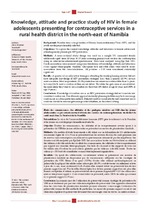Knowledge, attitude and practice study of HIV in female adolescents presenting for contraceptive services in a rural health district in the north-east of Namibia

View/
Date
2012Author
Ntumba, Alexis
Scott, Vera
Igumbor, Ehimario U.
Metadata
Show full item recordAbstract
Background: Namibia bears a large burden of Human Immunodeficiency Virus (HIV), and the
youth are disproportionately affected.
Objectives: To explore the current knowledge, attitudes and behaviour of female adolescents
attending family planning to HIV prevention.
Methods: A cross-sectional study design was used on a sample 251 unmarried female
adolescents aged from 13 years to 19 years accessing primary care services for contraception
using an interviewer-administered questionnaire. Data were analysed using Epi Info 2002.
Crude associations were assessed using cross-tabulations of knowledge, attitude and behaviour
scores against demographic variables. Chi-square tests and odds ratios were used to assess
associations from the cross-tabulations. All p-values < 0.05 were considered statistically
significant.
Results: A quarter of sexually active teenagers attending the family-planning services did not
have adequate knowledge of HIV prevention strategies. Less than a quarter (23.9%) always
used a condom. Most respondents (83.3%) started sexual intercourse when older than 16 years,
but only 38.6% used a condom at their sexual debut. The older the girls were at sexual debut,
the more likely they were to use a condom for the event (8% did so at age 13 years and 100% at
age 19 years).
Conclusions: Knowledge of condom use as an HIV prevention strategy did not translate into
consistent condom use. One alternate approach in family-planning facilities may be to encourage
condom use as a dual protection method. Delayed onset of sexual activity and consistent use of
condoms should be encouraged amongst schoolchildren, in the school setting.
